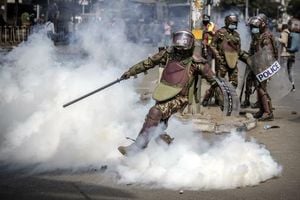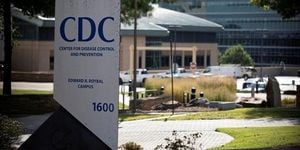Hundreds of tourists who stayed at Wyoming’s Grand Teton National Park are being urgently contacted by health officials after a bat infestation at the Jackson Lake Lodge led to fears of possible rabies exposure. The situation has set off a scramble across 38 U.S. states and seven countries as authorities work to reach everyone who may have spent the night in eight specific cabins where bats had taken up residence in the attic, according to statements from the Wyoming Department of Health and the National Park Service.
The alarm was first raised on July 27, 2025, when staff at the Grand Teton Lodge Company discovered evidence of a bat colony above a row of guest cabins. The affected cabins—numbered 516, 518, 520, 522, 524, 526, 528, and 530—had opened for the summer season in May after being shuttered over the winter. By the time the problem was identified and the cabins closed, officials estimate that up to 500 people had stayed there, based on roughly 250 reservations through late July. The cabins have remained unoccupied since, with no plans to reopen them anytime soon, as reported by the Associated Press.
As of August 15, none of the bats that were captured and tested at the Wyoming State Veterinary Laboratory in Laramie had been found positive for rabies. Three or four dead bats tested negative, while one mangled specimen could not be tested due to insufficient brain tissue, according to Emily Curren, Wyoming’s public health veterinarian. All the bats were brown bats—either the “little” or “big” species, both common in Wyoming and known to live in colonies of 30 to 100 individuals. The actual number of bats in the attic is believed to be much higher than the handful recovered for testing, leaving officials unable to rule out the risk of rabies exposure from the rest of the colony. “That’s a lot of bats that we cannot rule out a risk of rabies being in,” Curren told the Associated Press. “There’s no way for us to know for certain about every single bat that got into these rooms.”
Rabies is a deadly virus, almost always fatal in humans once symptoms appear. The virus is most often transmitted by animal hosts such as bats, raccoons, skunks, and foxes. The Centers for Disease Control and Prevention (CDC) notes that less than ten rabies deaths occur in the U.S. each year, but about 70 percent of these are linked to bat exposures. “The first symptoms of rabies may be like the flu, including weakness or discomfort, fever, or headache. There also may be discomfort, prickling, or an itching sensation at the site of the bite,” the CDC explains. Within two weeks, symptoms can progress to anxiety, confusion, agitation, and hallucinations, followed by more severe neurological signs such as hydrophobia, excessive saliva production, and aggressive behavior. At this advanced stage, rabies is almost always fatal.
What makes this outbreak particularly concerning is the stealthy nature of bat bites. According to the National Park Service, “bat bites are small, often hard to see, and typically do not bleed or cause pain. A person may not realize that an exposure has occurred or may not think a bite or scratch requires medical attention.” This means that people who are deep sleepers, children too young to communicate, or those with mental impairments could be at risk without knowing it. “What we’re really concerned about is people who saw bats in their rooms and people who might have had direct contact with a bat,” Dr. Alexia Harrist, Wyoming State Health Officer, told the Associated Press.
Officials are recommending post-exposure prophylactic treatment—which consists of a series of four to five shots over two weeks along with a dose of human rabies immune globulin (HRIG)—for guests who fit specific risk criteria. This includes anyone who saw a bat in their room, woke up to find a bat present, or cannot reliably say whether they had contact with a bat. The good news, according to Dr. Harrist, is that “if people didn’t see a bat in the room, it’s extremely unlikely that they have any risk for rabies.” However, she cautioned, “if you stayed in one of the affected cabins, you should reach out to health officials or your doctor immediately.”
Dr. Travis Riddell, director of Teton County’s Public Health Department, echoed the need for caution. “The chances of even one of [the bats] having rabies or having been exposed to rabies is low… but to me, the death of one person because of something that we could have otherwise prevented is not acceptable,” he told Wyoming Public Radio. The National Park Service also emphasized that exposure can result not only from bites or scratches, but also from saliva contact with an open cut or mucous membrane.
Tracking down the potentially affected guests has proven to be a logistical challenge, as many have returned to their homes across the country or abroad. Health officials are collaborating with state agencies and the CDC to notify guests in 38 states and seven countries. For those not yet reached, authorities urge anyone who stayed in cabins 516, 518, 520, 522, 524, 526, 528, or 530 between May 5 and July 27, 2025, to contact the Grand Teton Lodge Company or their healthcare provider as soon as possible.
While the risk to the broader community is considered very low, the incident has prompted a thorough review of safety protocols at Jackson Lake Lodge. Devices have been installed to prevent bats from re-entering the cabins after they fly out to feed, and there are no plans to exterminate the bats, according to Grand Teton National Park spokesperson Emily Davis. “The lodge company has done a fantastic job of doing their due diligence of making sure everyone that is coming in for that, and for all other visits this year, are going to be as safe as possible,” Curren said.
The bat infestation and subsequent health scare come just days before the Federal Reserve’s annual economic policy symposium, scheduled for August 21-23 at Jackson Lake Lodge. Officials have assured that the main lodge and other accommodations remain safe, and that all necessary precautions are being taken to protect guests and staff during the high-profile event.
For those potentially exposed, the financial implications of post-exposure rabies treatment are significant. According to BetterCare, a healthcare cost tracking website, the regimen can cost anywhere from $2,500 to $7,000, with some cases—especially those treated at smaller hospitals—reporting charges as high as $10,000 or more. Despite the expense, the treatment is highly effective if administered promptly after exposure.
With the cabins sealed off and the bat colony contained, the focus now turns to ensuring that every potentially exposed person gets the information and care they need. While the odds of infection are low, officials are taking no chances. As Dr. Riddell put it, “the death of one person because of something that we could have otherwise prevented is not acceptable.”
The episode at Grand Teton serves as a stark reminder: even in the most picturesque settings, hidden risks can lurk overhead. For now, health officials are betting on caution, communication, and science to keep a summer scare from turning tragic.






